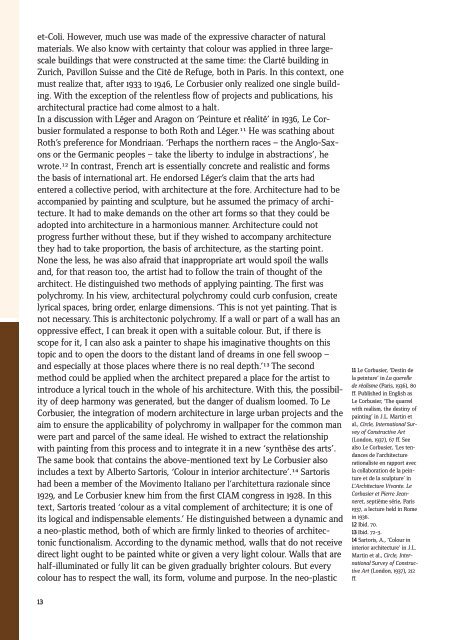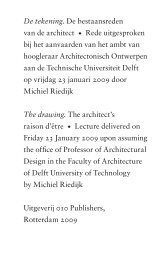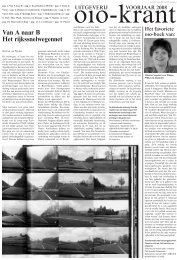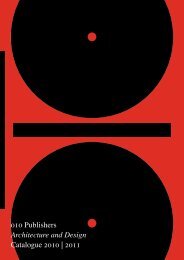The Architectonic Colour - 010 Publishers
The Architectonic Colour - 010 Publishers
The Architectonic Colour - 010 Publishers
Create successful ePaper yourself
Turn your PDF publications into a flip-book with our unique Google optimized e-Paper software.
et-Coli. However, much use was made of the expressive character of natural<br />
materials. We also know with certainty that colour was applied in three largescale<br />
buildings that were constructed at the same time: the Clarté building in<br />
Zurich, Pavillon Suisse and the Cité de Refuge, both in Paris. In this context, one<br />
must realize that, after 1933 to 1946, Le Corbusier only realized one single building.<br />
With the exception of the relentless flow of projects and publications, his<br />
architectural practice had come almost to a halt.<br />
In a discussion with Léger and Aragon on ‘Peinture et réalité’ in 1936, Le Corbusier<br />
formulated a response to both Roth and Léger.¹¹ He was scathing about<br />
Roth’s preference for Mondriaan. ‘Perhaps the northern races – the Anglo-Saxons<br />
or the Germanic peoples – take the liberty to indulge in abstractions’, he<br />
wrote.¹² In contrast, French art is essentially concrete and realistic and forms<br />
the basis of international art. He endorsed Léger’s claim that the arts had<br />
entered a collective period, with architecture at the fore. Architecture had to be<br />
accompanied by painting and sculpture, but he assumed the primacy of architecture.<br />
It had to make demands on the other art forms so that they could be<br />
adopted into architecture in a harmonious manner. Architecture could not<br />
progress further without these, but if they wished to accompany architecture<br />
they had to take proportion, the basis of architecture, as the starting point.<br />
None the less, he was also afraid that inappropriate art would spoil the walls<br />
and, for that reason too, the artist had to follow the train of thought of the<br />
architect. He distinguished two methods of applying painting. <strong>The</strong> first was<br />
polychromy. In his view, architectural polychromy could curb confusion, create<br />
lyrical spaces, bring order, enlarge dimensions. ‘This is not yet painting. That is<br />
not necessary. This is architectonic polychromy. If a wall or part of a wall has an<br />
oppressive effect, I can break it open with a suitable colour. But, if there is<br />
scope for it, I can also ask a painter to shape his imaginative thoughts on this<br />
topic and to open the doors to the distant land of dreams in one fell swoop –<br />
and especially at those places where there is no real depth.’¹³ <strong>The</strong> second<br />
method could be applied when the architect prepared a place for the artist to<br />
introduce a lyrical touch in the whole of his architecture. With this, the possibility<br />
of deep harmony was generated, but the danger of dualism loomed. To Le<br />
Corbusier, the integration of modern architecture in large urban projects and the<br />
aim to ensure the applicability of polychromy in wallpaper for the common man<br />
were part and parcel of the same ideal. He wished to extract the relationship<br />
with painting from this process and to integrate it in a new ‘synthèse des arts’.<br />
<strong>The</strong> same book that contains the above-mentioned text by Le Corbusier also<br />
includes a text by Alberto Sartoris, ‘<strong>Colour</strong> in interior architecture’.¹⁴ Sartoris<br />
had been a member of the Movimento Italiano per l’architettura razionale since<br />
1929, and Le Corbusier knew him from the first CIAM congress in 1928. In this<br />
text, Sartoris treated ‘colour as a vital complement of architecture; it is one of<br />
its logical and indispensable elements.’ He distinguished between a dynamic and<br />
a neo-plastic method, both of which are firmly linked to theories of architectonic<br />
functionalism. According to the dynamic method, walls that do not receive<br />
direct light ought to be painted white or given a very light colour. Walls that are<br />
half-illuminated or fully lit can be given gradually brighter colours. But every<br />
colour has to respect the wall, its form, volume and purpose. In the neo-plastic<br />
13<br />
11 Le Corbusier, ‘Destin de<br />
la peinture’ in La querelle<br />
de réalisme (Paris, 1936), 80<br />
ff. Published in English as<br />
Le Corbusier, ‘<strong>The</strong> quarrel<br />
with realism, the destiny of<br />
painting’ in J.L. Martin et<br />
al., Circle, International Survey<br />
of Constructive Art<br />
(London, 1937), 67 ff. See<br />
also Le Corbusier, ‘Les tendances<br />
de l’architecture<br />
rationaliste en rapport avec<br />
la collaboration de la peinture<br />
et de la sculpture’ in<br />
L’Architecture Vivante. Le<br />
Corbusier et Pierre Jeanneret,<br />
septième série, Paris<br />
1937, a lecture held in Rome<br />
in 1936.<br />
12 Ibid. 70.<br />
13 Ibid. 72-3.<br />
14 Sartoris, A., ‘<strong>Colour</strong> in<br />
interior architecture’ in J.L.<br />
Martin et al., Circle, International<br />
Survey of Constructive<br />
Art (London, 1937), 212<br />
ff.









